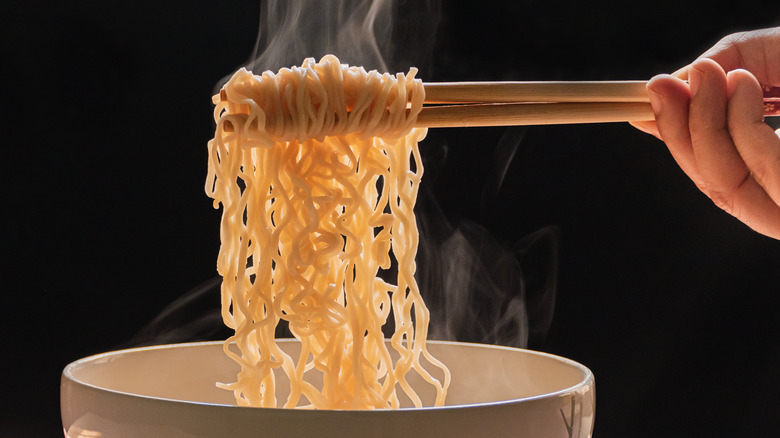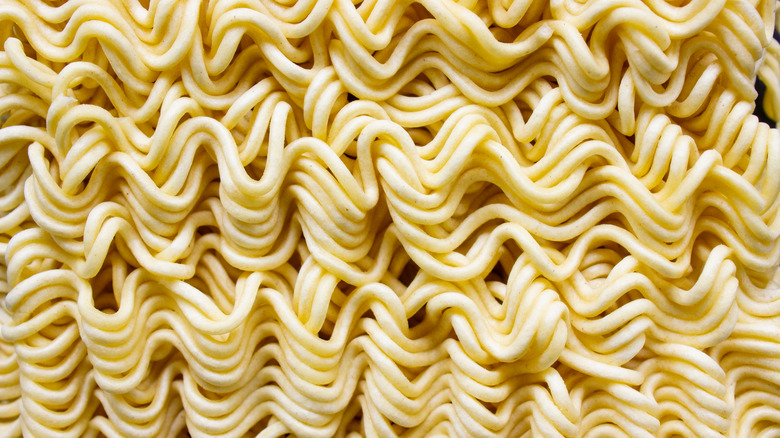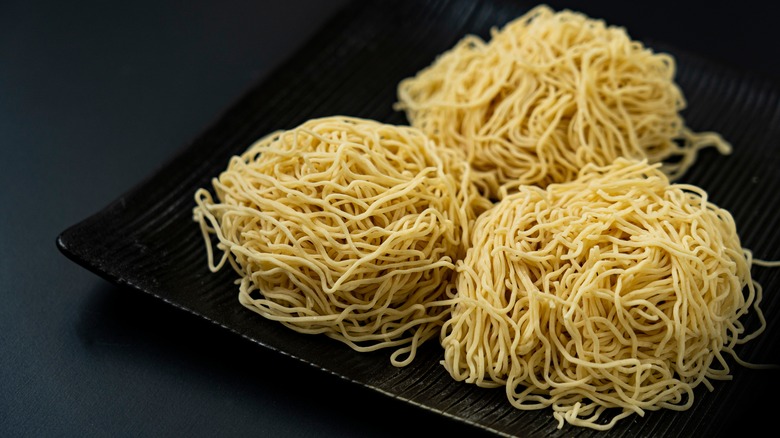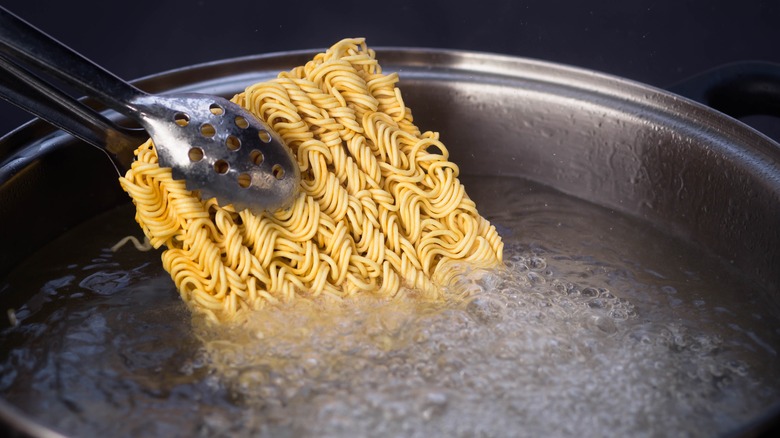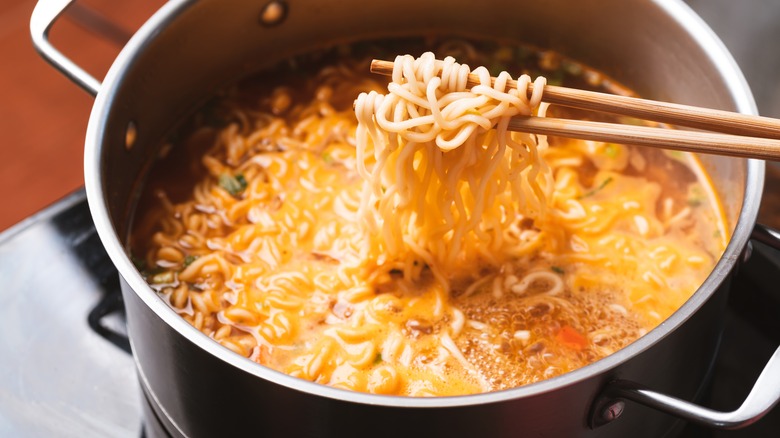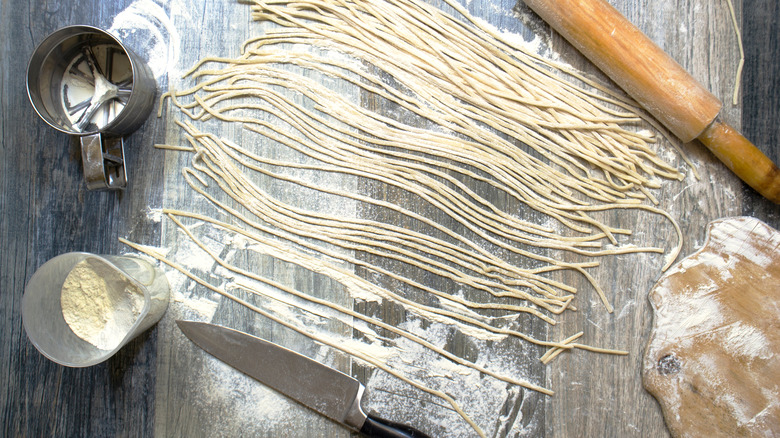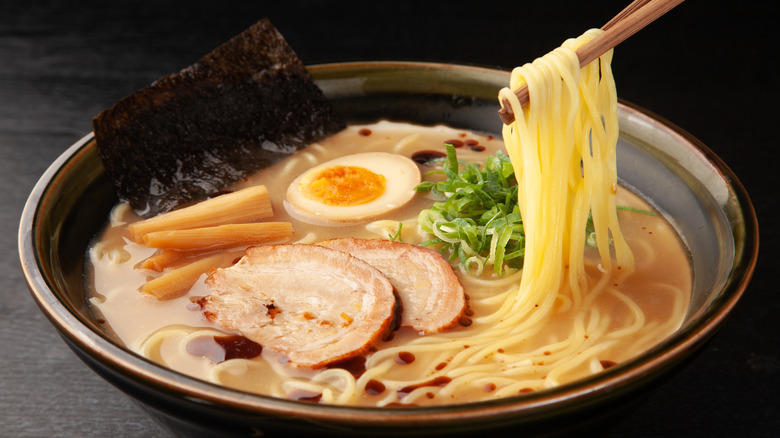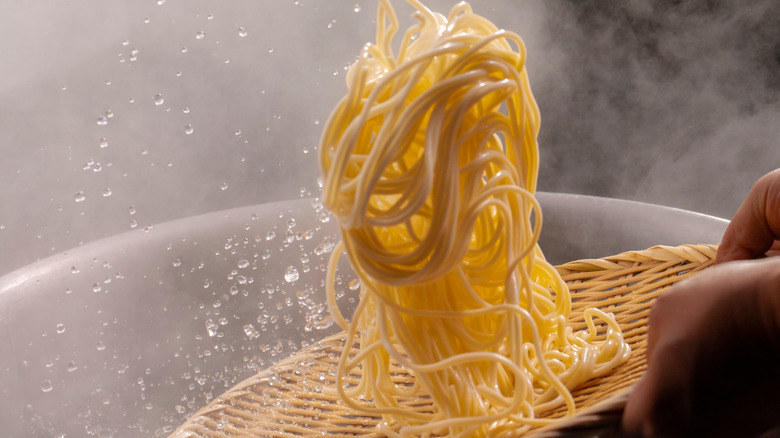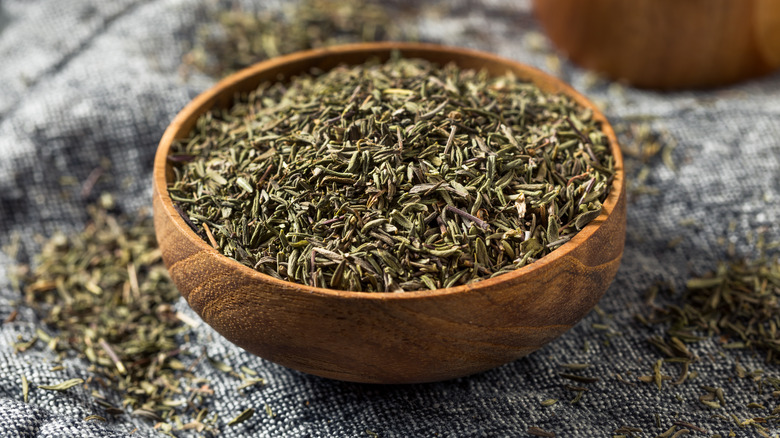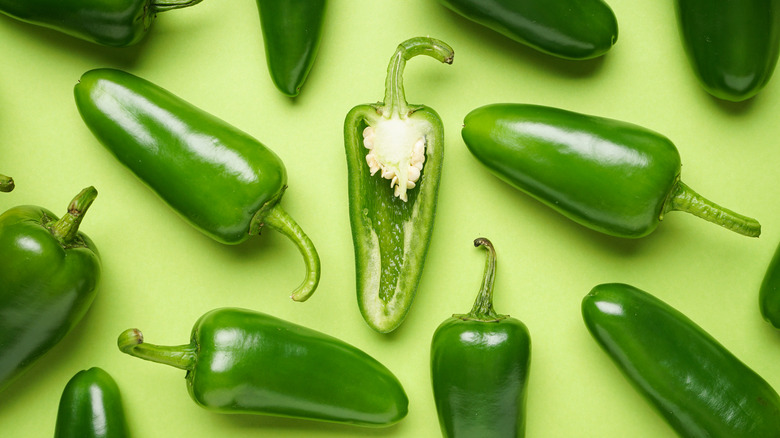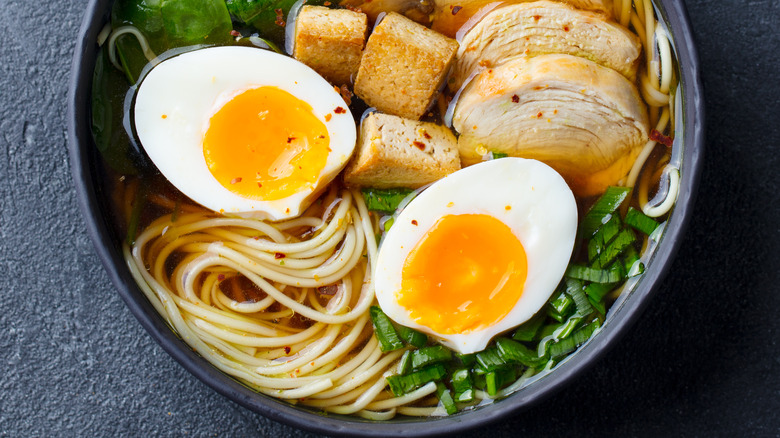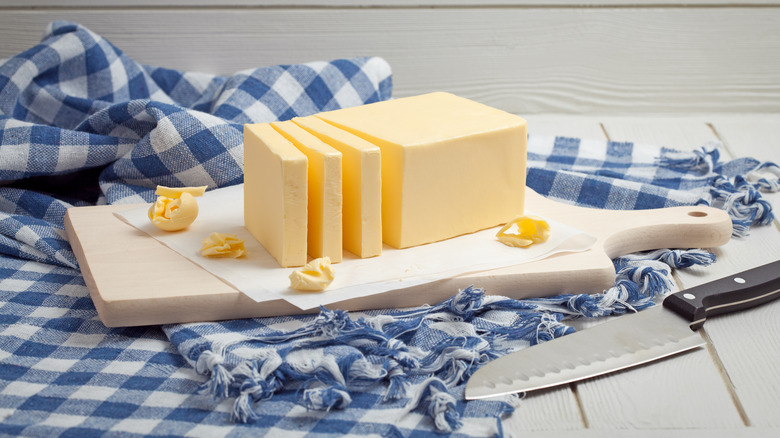Mistakes People Make When Cooking Ramen
If you were to ask someone about ramen, there's a good chance they'll bring up college and those blocks of instant ramen that were easy to make in a dorm and even easier on a student's budget. And between instant ramen's widespread availability and affordability, that's not surprising. But there's a great deal more to ramen and the many types of dishes that feature it.
Nevertheless, since instant ramen is so well known, let's first learn a little more about this popular type of ramen. According to Cup Noodles Museum in Yokohama, Japan, the man known as "The Father of Instant Ramen" is Momofuku Ando. After a great deal of trial and error, he finally invented Chicken Ramen in 1958 and was inspired by a trip to America to create Cup Noodles in 1971. He even came up with a special kind of ramen that could be consumed in space in 2005. Today, his work is the focus of not just the Yokohama Cup Noodles Museum but also the ones located in Osaka Ikeda (Japan) and Hong Kong.
A takeaway from Momofuku Ando's life is that when it comes to food, it might take more than one try to get the results you want. And this is true of making ramen. The trick is knowing what cooking rules you need to follow, so you'll also know where you can think outside the box and truly make a ramen meal your own.
Sticking with only instant ramen
Even though instant ramen is widely known, it's just one type. As Sun Noodle points out, some of their ramen noodle products are shipped fresh. And, yes, fresh noodles aren't the same thing as instant ones.
Chances are when you see instant ramen in the store, it's sitting on a shelf. And it's very unlikely you'd put uncooked instant ramen noodles in your refrigerator or freezer. But Sun Noodle advises on their website that "Upon receiving your order, if Ramen Kits are not consumed right away, please place the kits in the FREEZER immediately." So, for example, if you like Shoyu ramen, which uses ingredients like soy sauce and dashi stock (via Master Class), you could order a Shoyu ramen kit from Sun Noodle. But unlike instant ramen, you couldn't just stick it in your pantry and wait until you were in the mood for it.
In addition, Sun Noodle also has frozen ramen noodles, which are especially useful for places like grocery stores and restaurants. Plus, according to Mashed, Costco customers were enthusiastic about tonkotsu (pork-bone broth) ramen kits, which included ingredients like a vegetable topping and chasu pork.
Besides the different store bought ramen, a person can also make ramen noodles from scratch. However, as the site Ginger and Scotch cautions, ramen dough can be difficult to kneed. In fact, you might want to invest in a pasta machine to keep from straining your hands.
Thinking there's only one kind of ramen noodle
Just as there are all different types of ramen products (instant, fresh, etc.), there's also different kinds of ramen noodles based on qualities like their ingredients. Just ask Yamato Noodle, a company that specializes in noodle making equipment and educating culinary professionals in the art of ramen making.
As Yamato Noodle explains, wheat is a classic ingredient of ramen noodles that goes back to their creation. However, you can make gluten-free ramen by using flour that doesn't come from wheat. Also, you don't necessarily need to use eggs in a ramen noodle recipe. However, if you opt for an egg-free ramen, it will affect the noodles' flavor and appearance. Plus, ramen noodles come in different shapes, including square ("Kaku-giri"), round ("Maru-giri"), and flat ("Hira-uchi"). But a simple way to control the shape of noodles is using a noodle cutting machine.
In addition to their ingredients and shapes, ramen noodles are classified by their water content or their hydration (via Yamato Noodle). In other words, noodles absorb a certain amount of water when they're cooked, so it's important to be aware of that particular noodle's hydration classification to get the best results. In the case of ramen, different types can have a low, a medium, or a high water content — in general, thicker, wider ramen noodles have a higher water content than thinner ones.
Thinking you have to boil instant ramen in water
Now, don't worry. There's nothing wrong with boiling instant ramen in water. In fact, Rapid Ramen Cooker talks specifically about the time it takes to boil water when one cooks ramen noodles on a stovetop. But if that's the only way you cook instant ramen, you might be missing out.
As Mashed reported, someone posted a variation on cooking a "ramen brick." They explained that cooking the ramen in broth instead of water means you don't necessarily need to use that packet of seasoning that commonly comes with instant ramen. Now, of course, one of the appeals of instant ramen is its low price. But as the person on reddit pointed out, you can "Buy a carton of beef or chicken stock for a couple of bucks, then simmer that on the stove with some green onions, garlic, chili paste, peppercorns, and fish sauce. Throw your ramen brick in for a couple minutes and you're done!"
While you could just use broth to cook instant ramen, you can also add the seasoning packet to the broth. But be careful. You don't want to overpower your broth with too much flavor. Instead, trying adding a little at a time and taste-testing your creation before adding your instant ramen.
Cooking all types of ramen the same way
If you've ever painted, then you know you can't work with oil paints the same you would watercolors or acrylics. And if you try, you're not going to get the results you want. The same thing is true for ramen noodles.
Now, as we talk about elsewhere in this article, there's instant ramen, which you can technically cook in either water or broth. But that's not the case for refrigerated organic ramen noodles like Umi Organic produces. As the company's website cautions, you need to cook these noodles in water before transferring them into the broth. Why? Well, not only could skipping the boiling water step lead to these type of ramen noodles not cooking properly, the starch on the outside of the noodles could "muddy your broth." The company also notes that you need more water to cook fresh ramen than you do when you're making dried ramen.
Okay, but what about frozen ramen? Well, Umi Organic strongly recommends defrosting their frozen ramen in the refrigerator overnight before attempting to boil them in water. But if you're pressed for time, you can also microwave them for about 30 seconds. Additionally, you should carefully separate the noodles and fluff them out before putting them in boiling water.
Leaving out a key ingredient in your dough
So, you've decided to make ramen noodles from scratch. You've measured out your ingredients, watched more YouTube videos than you want to count on how to properly kneed the dough and cut the noodles — you feel like you're ready to go. But if you're using regular water to make your ramen, you're not going to get the results you want.
This is because once upon a time, a key ingredient in many ramen noodle dough recipes was well water, via Cilantro and Citronella. This is because of the alkaline nature of this type of water, which not only gave the noodles their familiar color and texture but also helped keep them from dissolving while being boiled. But don't worry if there isn't a well on your property. Modern ramen makers add a liquid called kansui to their dough's water. And since kansui contains potassium carbonate and sodium bicarbonate, the results are water with the right amount of alkalinity for your ramen noodles.
Unfortunately, not every supermarket carries kansui (per Cilantro and Citronella). But not to worry. You do have options. For one, kansui is available online. But if you're already at the grocery store and need to pick up your ramen ingredients right away, you can always substitute it for baking soda.
Not cleaning the bones for the broth
As Nishiyama Seimen Co. Ltd. points out, there are many different types of bones that can go into ramen soup broth. For instance, pork bones like ribs, legs, spines, and knuckles, as well as bones from the head, are all used to make ramen broth. However, chicken and beef bones are also used in ramen soup recipes. But one error you want to avoid is not cleaning the bones being used for broth.
According to Glebe Kitchen, in order to make the best version of pork-based ramen soup (i.e. tonkotsu ramen broth), you should use a method called blanching where you boil the bones for five minutes, then dump out the water, rinse the bones, and only then start making your broth. Now, this might sound a bit wasteful, but as the site explains, those five minutes on the stove help to get rid of muck from the bones that can take away from the stock.
Although blanching the bones is an extra step, it doesn't take that long — especially when compared to making tonkotsu ramen broth from scratch. Once the pork bones are ready, you'll need to keep them at a rolling boil for a full 12 hours to get that savory broth that pairs so well with ramen (via Glebe Kitchen). And if you think once the bones are boiling you just have to wait, think again. You'll need to periodically add water to keep the bones submerged.
Not using the right kind of water
We talk about elsewhere in this article how important the pH is for the water you use to make the dough for your ramen noodles. But even if you make perfect ramen dough, boiling it in the wrong kind of water can throw off your noodles.
Yamato Noodle recommends cooking ramen noodles in soft water. This is because unlike soft water, hard water is full of minerals like magnesium and calcium, which can make it more challenging for the water to enter the noodles. This can mean you'll need to cook the noodles for a longer period of time, and that can lead to rougher noodles with a less appetizing texture. And remember, if you throw those noodles into hot soup, they're more likely to become softer quicker rather than being a pleasing al dente. Additionally, cooking noodles longer can result in less noodles since they melt while they're being cooked.
So, if you want to get the best out of your ramen noodles just remember hard water makes it harder for your noodles to cook correctly. And Yamato Noodle has one more tip: If you want less noodles to melt, make sure the pH of your cooking water has a light alkalinity of 9-10.
Not adding flavor to your broth beyond the seasoning packet
Let's be honest. When you've had a long day, that convenient little seasoning packet that comes with instant ramen can feel like the shortcut you needed for dinner. After all, there's no measuring required and no guesstimating on how much is too much. But with just a little extra effort, you can up your ramen game to the next level.
According to the Golden Lion Restaurant, certain spices will really enhance your ramen's flavor. And good news, you probably have most of these in your spice rack. For a little heat, you might want to try red chili flakes, curry powder, garlic powder, or white pepper. Other good spices to pair with ramen include cumin, star anise, and even cinnamon. However, to really kick your bowl of ramen up from a nine to a 10, nothing quite works as well as thyme. Specifically, you want to opt for fresh thyme, but 1 teaspoon of dried thyme will also work.
Although dry ingredients can be great additions for ramen, you don't want to overlook liquid ones. For example, if you like spicy dishes, the Golden Lion Restaurant recommends adding sriracha to your ramen. How much, of course, depends on your tastes, but a good starting point is 1 tablespoon of sriracha, which will give you a medium spicy meal. In fact, the restaurant advises letting that tablespoon cook with the other ingredients for a while before experimenting with adding more.
Not adding other foods to your instant ramen
Here's a not-so-fun-fact about ramen. According to Mashed, those little flavor packets that come with instant ramen can contain MSG. And for some people, MSG is definitely on their avoid foods list. But don't worry, that doesn't mean you have to settle for plain noodles.
As Mashed further explains, there's plenty of savory options to pair with your ramen noodles. We touch on adding seasoning and spices in this article, but don't sell short herbs like basil, cilantro, and mint to give your ramen that little something extra. And let's not stop there. Chances are you've got some vegetables in the fridge or freezer, and either kind can be fine for your ramen. For instance, you might want to add jalapeños for a spicy, satisfying meal. Or how about broccoli, bok choy, green onions, or bean sprouts?
Now, you might be thinking that a meal for you just isn't going to hit the spot if it doesn't have protein. But don't worry, meat like chicken, bacon, or shrimp can all go with ramen (via Mashed). And don't forget eggs are also great sources of protein and commonly part of ramen dishes. The point is it doesn't take much to up your ramen game while lowering your MSG intake.
Overcooking your egg
Technically, you can add just about any properly cooked egg to a bowl of ramen (via Mashed). But if you want that classic, Instagram-worthy bowl of ramen, fried eggs and hard boiled ones just won't do. No, to get that picture perfect dish, there's no substitute for a soft boiled egg.
As Mashed explains, you'll need a few items to make the perfect soft boiled egg, such as a small saucepan and either tongs or a spoon. First, you'll want to fill the saucepan with water, but not too much. The egg should just be able to be submerged in the water. Bring the water to a boil and then using either the tongs or the spoon, move the egg from the fridge directly into the saucepan. Now, here's the crucial part. You only want to boil the egg for about six minutes to get that ramen bowl ideal egg. And, of course, you'll need to peel it, but there's a trick to this. When you take the egg out of the saucepan, run it under cold water. In fact, you want to peel it under that steady water stream to get the best results.
Once you've peeled your egg, you can set it aside as you prepare the rest of your ingredients for your bowl of ramen (per Mashed). Eventually, however, you will need to slice it once from top to bottom and arrange it yolk side up in the bowl — just like all those lovely photos!
Thinking dairy and ramen don't mix
When you think of a classic bowl of ramen, you probably imagine not just noodles but ingredients like eggs and narutomaki (a.k.a. fishcakes with a swirly design). But there's a good chance you don't associate ramen with dairy products like cheese. Unfortunately, this could mean you're missing out on some tasty ramen dishes.
According to Mashed, Roy Choi's ramen book includes a recipe where if you add American cheese to your ramen broth, you can up its creaminess. And good news: Both white and yellow American cheese can work well in this ramen dish (or since it calls for two slices, you can try a little of each). Plus, 5 AM Ramen touts a shop in Japan called Tsukumo Ramen (九十九ラーメン) where cheese ramen is a regular on the menu. For their tonkotsu ramen, which uses pork bone broth, they add Gouda cheese and a little miso broth. In addition, they also make Tomato Cheese Ramen that the site describes as "a sort of rich tomato soup."
Even if cheese isn't your thing, that doesn't mean dairy is completely off the table when it comes to your ramen creations. As Tasting Table explains, adding butter to ramen can take some of the bite out of a spicy ramen dish while still helping the various flavors of the meal blend together.
Overcooking ramen
Imagine this: You're in your kitchen, cooking ramen on your stove. No sooner do you get the noodles in the pot when your cellphone starts ringing. Thinking "Murphy's Law," you take the call and lose track of time. As soon as you realize the noodles have been boiling for too long, you shut off the burner and hope they'll be alright.
Now, let's be clear. Ramen noodles that are a little overcooked shouldn't be a problem to eat. But they're definitely not the best results for a perfectly appetizing ramen dish. As ramen expert Brian MacDuckston told Smithsonian Magazine,"... They say you have eight minutes in the soup before the noodle starts to overcook," adding that you should also stir the noodles as they cook. However, if you do make a mistake, don't be too hard on yourself. According to SheKnows, it's very easy to overcook noodles, which can affect their texture. Yes, if you like your noodles al dente, overcooking them all but guarantees they'll be the exact opposite: overly soft and limp. Plus, cooking noodles for too long can change their glycemic index, which as Self explains, can change how they affect your blood sugar levels.
So, how can you avoid this kitchen issue? Well, SheKnows recommends setting the timer for a couple of minutes sooner. In other words, if you're planning to cook your ramen noodles for eight minutes, set the timer for six minutes and check a noodle for consistency.
Not using the best utensil
Okay, so you've gone the extra mile and created that perfect bowl of ramen. It looks good, it smells wonderful, and you can't wait to taste it. But what's the point of crafting a perfect meal if it falls short on the very last step? Yes, we're talking about the utensil you use to eat it. And, yes, that can make a difference in terms of the taste of your ramen.
Now, if you've always used forks to eat your food, you probably feel very comfortable with them. And there's no denying that chopsticks and forks don't work the same way, so you might not feel as comfortable with chopsticks. But if you love ramen, you might want to consider practicing using chopsticks since, as Ramen Hero notes, they're the ideal tool for slurping your ramen. Wait, slurping? Isn't that bad manners? Actually, there is a loophole since slurping both helps to cool the noodles and aerates them, which heightens their flavor. Of course, you could use a fork, but that can be messy and less effective than using chopsticks.
If you're interested in trying chopsticks but are concerned you won't be able to use them without making a mess, you have options. For example, Marcus & Marcus sells chopsticks that have support rings for one's fingers and a hinge design. Granted, these particular chopsticks are more designed for children, but there are training chopsticks on the market for adults, too.
Not considering ramen for dessert
Chances are when you think of ramen, your mind immediately goes to lunch or dinner. But remember, ramen is a versatile food that can be crafted to go beyond these mealtimes. As Mashed points out, adding a little bacon and eggs can give you a breakfast take on ramen. But here's a completely outside the box idea — ramen for dessert.
Tasting Table notes that you can make Ramen Truffle Balls. Yes, chocolate and ramen together in one dish. How? Well, think for a moment about the variety of truffles on the market. Sometimes, a confectionary chef will sprinkle foods like diced nuts or dried bits of coconut on them. Swap out the nuts or coconut for ramen, and you have a unique dessert idea. Also, The Cherished Bite has crafted a new spin on classic Rocky Road bars that incorporates ramen into the recipe, according to Trend Hunter. By combining crushed ramen with raspberries, toasted peanuts, pistachios, and white chocolate, you get a sweet, fruity treat rather than a savory meal.
The bottom line is you can really let your creative juices fly when it comes to ramen. Does that mean every dish will be a bragworthy culinary success? No, but sometimes what might seem like unlikely combinations can yield tasty results.
Not everything should be done with ramen
There's no denying that ramen noodles are versatile enough that with a little creativity, you can craft your perfect dish. But just because you can do something with ramen doesn't necessarily mean you should.
Take what happened with Diamonté Quiava Valentin Harper or as she's better known Saweetie (via IMDb). A rapper, actress, director, composer, and producer, Saweetie's resume includes being featured on the soundtracks for such movies as "Birds of Prey," as well as the soundtracks for TV shows like "Claws" and "Basketball Wives." But as Mashed pointed out, her TikTok video labeled "The correct way to make ramen" received some criticism. Using Cup Noodles, she started by adding Tony Chachere's seasoning and Tabasco sauce. Although some people like to drink the liquid in Cup Noodles, she drained it out over the sink before emptying all the noodles into a Flamin' Hot Cheetos bag. And, no, she wasn't using an empty bag and taking advantage of the Cheetos dust. When she starts eating the ramen, there's a Cheeto sitting on top of the noodles on her fork.
While the video received millions of likes, it also got comments like "radioactive bowel movements" and statements that they wouldn't be trying this recipe themselves. However, Saweetie's official website's homepage has a screenshot from the video with the yearbook-like captions: "Saweetie TikTok" and "Most likely to be a comedian."
